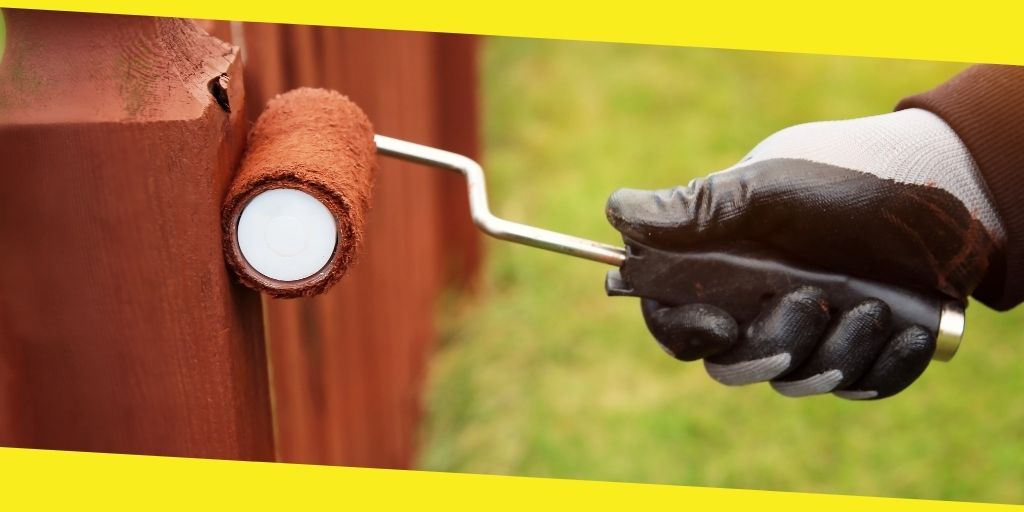Painting Outside? Avoid These Mistakes!

Did having to stay indoors most of last year see you becoming something of a DIY enthusiast? Are you now well versed with using a screwdriver and paintbrush? Has every inch inside your home been painted from top to bottom? Then your work is all done, right?
Wrong! It is time to take things outdoors, my friend. Painting outside can seem daunting; after all, you don’t want people walking by and thinking something is wrong with your house. Truth be told, getting some paint cans cracked open and working away on a sunny day is simple, as long as you know what to avoid when painting different surfaces.
I want to take you on a quick journey through the different exterior surface types you’ll commonly paint outside the home, and how you can ensure you don’t make a mess of things. Let’s start with one exterior element every home needs: a front door.
Contents
ToggleMistakes to avoid when painting your front door & window frames
In the immortal words of Irish 90s girl group B*Witched, “I have a house with windows and doors/I’ll show you mine if you show me yours”. Do a bad job of painting your doors & windows, and you won’t want to show anyone.
Painting these areas is incredibly easy to do. It is also incredibly easy to do wrong. Doors and frames are two areas where heat and moisture are always lingering. You will notice that condensation sometimes builds up inside your windows in the colder months. At the same time, hot air will always want to seep out through the edges of doors. That means paint not only needs to protect the surface but ensure moisture won’t soon see it split.
When getting ready to paint around doors and windows, give it a thorough wet clean and let it dry in completely. You also want to ensure corners and glass are taped off, and that uneven surfaces are taken care of. If you’re using a smooth gloss or satin, applying some caulk to even out imperfections is a must.
Mistakes to avoid when painting on brickwork
Have you ever painted a room at home with some gloss, had a good chunk of change left over in the tin, and thought it could be best served on brickwork and stone outside? Not so fast pal. Brickwork is a tricky old thing to work with. While some interior paints (especially gloss) can be used on brick and concrete outside, please don’t go thinking it will work in your favour. If the gloss in your kitchen has trouble handling a sauce stain, imagine what the outside walls will look like with the same paint.
Always opt for a reliable masonry paint which is specifically formulated to protect and look good. Masonry paints tend to be thicker coats, so remember that your square footage per litre will be lower. You also want to opt for a surface-specific paint because you need breathability outside the house.
Mistakes to avoid when painting fences
There is no better sight from the kitchen on a bright morning while sipping on coffee than admiring your handiwork after painting your garden fence. Unless of course, you made the most common mistake when painting outside and now you’re wondering why your fence seems to look patchy.
This tip is primarily aimed at anyone painting a new fence, but also goes if you’re giving an older fence a new link of paint; prime like there’s no tomorrow. Your garden fence will be most reactive to changes in the seasons, and if your paint were applied to an unprepared piece of wood, it would not react how you want.
Always pop a primer or undercoat on fences and let it fully dry before painting. And if you are buying paint which says it “self-primes” don’t trust it. Now, it might work fine but assume that your fence won’t take it well and pop a coat on first.
Mistakes to avoid NOT painting fences
When is painting a fence not painting a fence? When you’re using stain. I want to take a slight detour on this paint path to highlight the biggest misconception people have when staining wood for their fences or any wooden surface stain of choice has to be, it is completely customisable to the colour that you want. That said, you never want to think that the colour on the can will match wood perfectly. Stains will react however they want to wood, and you shouldn’t expect a wood stain to match the exact shade until you’re at least three coats in. I liken it to the colour of Guinness. You would look at a pint and think it is black, but hold it up to a light to notice it is simply a very dark red.
Remember that wood stains are purely decorative and won’t protect wood unless the product says so. You will need oil or wax to go on top.
Mistakes to avoid when painting over metal
I wanted to leave metal until the end as it’s one area that people will usually steer clear of for fear of mucking things up. We’ve all seen metal out and about which is flaked and rusty around the edges. You just have to walk around the local park to see benches and gates with rusty patches. The reality is that painting on metal is almost too easy. You just need to think of it as buttering bread for a grilled cheese.
It may sound like a weird metaphor to have, but you always want to cover every exposed inch of bread hitting a hot pan in butter to crisp up and protect the inside. The same goes for metal. Metal needs to have every nook and cranny protected to avoid contact with the elements. Leave a tiny gap, air pocket, or water trapped between metal and paint, and you’ll end up with blistering, popping, or rusting. You always want to use a primer or undercoat on metal before one drop of paint is used. It will help avoid you running into trouble and ensure that if the paint has problems a few years after application, you know the undercoat is there to prevent the metal from oxidising.
Congratulations, you’re now a paint expert!
I hope all this advice will help you realise that the key to having the perfect looking paint on any surface is mainly down to preparation. As long as you don’t rush painting outside, and take care, you’re going to be extremely happy with how things turn out.
Thanks for reading. If you’re looking for more advice on sprucing your exterior, check out this recent article on using composite decking in your garden.
Most Inside
Most Inside offers high-quality recommendations and valuable updates to enhance all aspects of your life, providing premium guidance and enriching experiences.




